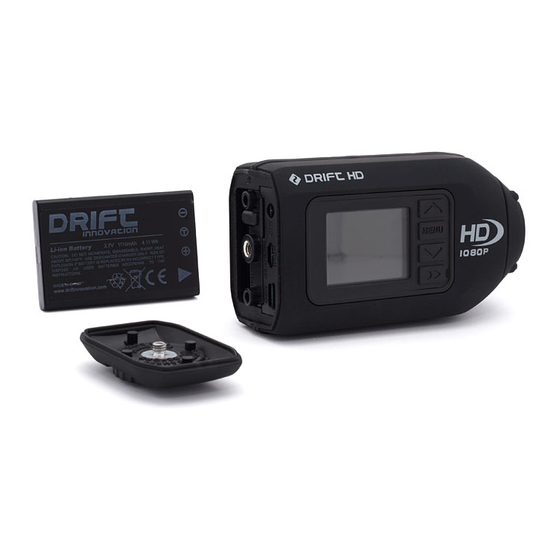DRIFT HD Manuel de l'utilisateur - Page 13
Parcourez en ligne ou téléchargez le pdf Manuel de l'utilisateur pour {nom_de_la_catégorie} DRIFT HD. DRIFT HD 17 pages.
Également pour DRIFT HD : Manuel de l'utilisateur (19 pages)

connecting the camera
You can copy your recorded video footage and photos to a PC or Mac computer by
using the included USB cable.
a) ConneCTinG The CaMeRa To a CoMPuTeR
Connecting to a Windows PC
1. Connect the camera to your PC using the USB cable. The camera will display a USB
logo instead of the Remaining Battery Indicator.
2. Your operating system may be set up to show a file window automatically.
Otherwise, double-click on the My Computer icon.
3. Your computer should recognize your camera as a Removable Disk. Look for the
DRIFT Removable Disk and double click on it to open.
4. Double-click on the 'DCIM' folder to open.
5. Inside the 'DCIM' folder you will find a folder called '100DRIFT' which contains all
photos and videos recorded on the Micro SD card. If there are a large number of
files, there will be multiple folders - 100DRIFT, 101DRIFT, etc.
6. Copy the desired video and photo files to your PC.
Connecting to a Mac
1. Connect the camera to your Mac by using the USB cable. The camera will display a
USB logo instead of the Remaining Battery Indicator.
2. Your operating system may be set up to show a file window automatically.
Otherwise, open the Finder.
3. Your computer should recognize your camera as an external device named DRIFT.
Click on it to open.
4. Click on the 'DCIM' folder to open.
5. Inside, the 'DCIM' folder you will find a folder called '100DRIFT', which contains all
photos and videos recorded on the Micro SD card. If there are a large number of
files, there will be multiple folders – 100DRIFT, 101DRIFT, etc.
6. Copy the desired video and photo files to your Mac.
Note: The battery does not need to be inserted or charged to copy files to a
computer.
Note: You can also copy data from the memory card by using a USB card reader (not
included). Your computer may also have an Micro SD card reader built into it, which
you can use to transfer your files.
b) PlayinG The ViDeo FooTaGe on a CoMPuTeR
1. Some computers may not have the correct codecs required for video playback and
editing.
2. If you experience difficulties playing video recorded with your camera, you can
download VLC media player for free from www.videolan.org
3. If you are experiencing difficulties editing video or do not wish to use VLC player for
playback, you will need to download and install a codec pack. The FFDshow codec
pack can be downloaded from www.free-codecs.com/FFDshow_download.htm
4. Do not forget that to play HD video files on your computer you require a computer
with a modern video card and plenty of RAM.
C) ConneCTinG The CaMeRa To a TV
1. While the camera is turned off, connect it to your TV using a Micro HDMI cable (not
included).
2. Switch the camera on.
3. Once booted up, the image usually displayed on the camera's LCD screen will
instead be displayed directly on your TV, and the sound will come out of the TV
speakers.
! Video cannot be recorded, nor photos taken while the camera is connected to a TV.
25
26
